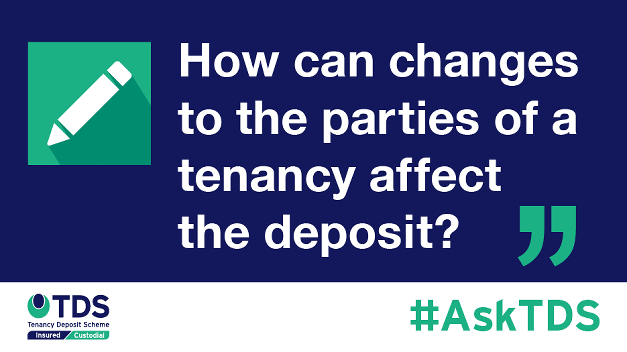#AskTDS: "How can changes to the parties of a tenancy affect the deposit?"

This week, Kelly Wallace, Senior Business Development Executive at Tenancy Deposit Scheme (TDS), answers an agent’s question: “How can changes to the parties of a tenancy affect the deposit?”
Circumstances can rapidly change during the lifespan of a tenancy, including the parties involved. It is important that the tenant change-over process is managed well to bring deposit liability for the outgoing tenant to an end.
There are some simple steps that landlords and agents can take to make sure the deposit remains properly protected and outgoing, incoming and remaining tenants are aware of their responsibilities at the end of the tenancy.
Where there is a change in the parties to a tenancy, the best approach is to bring the existing tenancy agreement to an end, then deal with the deposit, and finally create a new tenancy with a new deposit. Although this is the best approach, we appreciate that this option is not always achievable or practical.
How it works in practice for joint tenancies:
The landlord or agent repays any deposit amount due to the outgoing tenant (this amount may be £0.00), then the appropriate share of the deposit, detailed in the tenancy agreement, should be collected from the incoming tenant.
A new tenancy agreement may be drawn up, or an amendment may be made to the existing agreement to reflect the change in tenant.
Landlords and agents should ensure that the incoming tenant agrees in writing to be bound by the original inventory, making it clear that future deposit refunds will be based on this document.
For the old tenant, a waiver should be provided to clarify that they have received a refund of their share of the deposit and that they have no claim to the deposit under any new tenancy agreement.
If a new tenancy agreement has been entered into, the deposit registration for the old tenancy should be brought to an end.
The deposit for the new tenancy should be protected with a Government-approved deposit protection scheme, such as TDS within 30-days of receiving it. You can read more about the process of ending a tenancy in our handy guide.
TDS Custodial members benefit from a new, online tenant changeover function, which can simplify this process. Members can log in to their user account and remove the outgoing tenant from the deposit registration, including repaying them any amount they're owed.
If a new tenant or multiple tenants are moving in to replace the outgoing,, you can also add their details and ‘top up’ the protected deposit as part of the tenant changeover process.
The tenant changeover function should only be used if the parties are in agreement as to deductions being made from the deposit. As the tenancy is still on-going in these instances, the alternative dispute resolution cannot be used.
For more information on the tenant changeover functions, visit the TDS Custodial website or read our handy, step-by-step Guidance on a change of sharers mid-tenancy tool.
About the author:
Kelly Wallace has been part of The Tenancy Deposit Scheme for four years, initially within the Dispute Resolution team, progressing to a central role within the customer relations department and now the Senior Business Development Executive.

Kelly’s focus within TDS is membership, business development and growth; this encompasses all aspects of new business across both the Insured and Custodial schemes.
About TDS:
Tenancy Deposit Scheme (TDS) is a government-approved scheme for the protection of tenancy deposits; TDS offers both Insured and Custodial protection and also provides fair adjudication for disputes that arise over the tenancy deposits that we protect.
We provide invaluable training in tenancy deposit protection and disputes for agents and landlords through the TDS Academy as well as joining with MOL to provide the Technical Award in Residential Tenancy Deposits.
TDS Insured Scheme: where a TDS member can hold the tenancy deposits as stakeholder during the term of the tenancy.
TDS Custodial Scheme: where TDS hold the deposit for the duration of the tenancy.
TDS Academy: TDS provides property professionals with invaluable training in tenancy deposit protection and tenancy deposit disputes.
TDS can only comment on the process for our scheme, other deposit protection schemes may have a different process/require different steps. Content is correct at the time of writing.
These views are those of the author alone and do not necessarily reflect the view of TDS, its officers and employees.